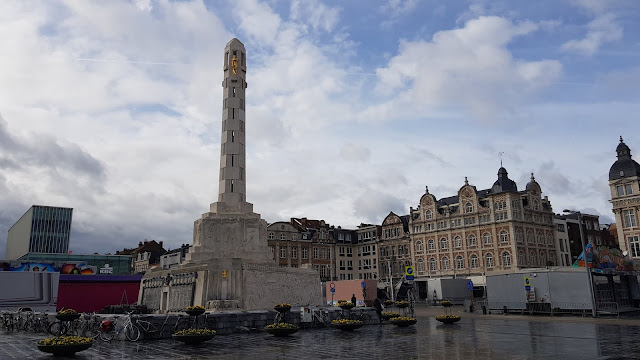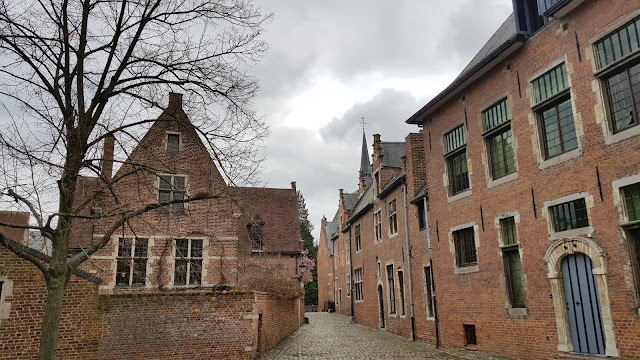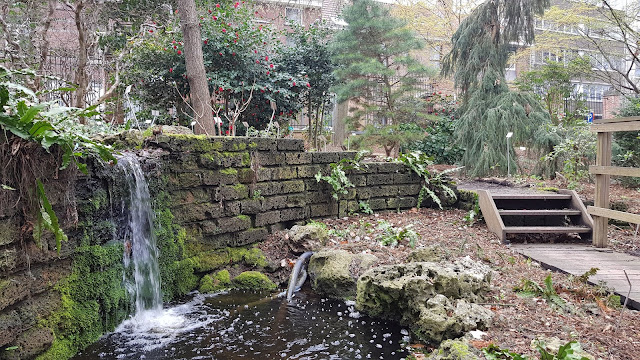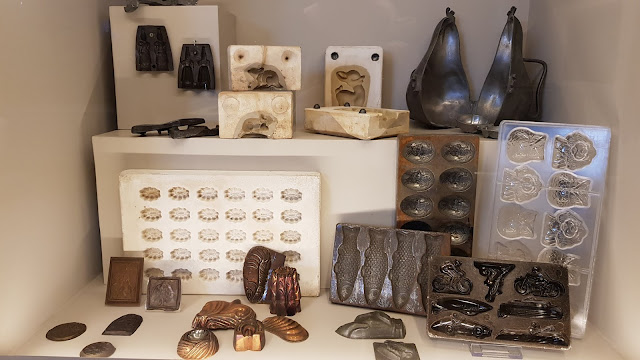Belgium 2019
A
short Spring Adventure in Belgium
This year, I decided to start my travel year with a short trip to
Belgium. After watching a football match in Mönchengladbach, I went to
Belgium to explore the country of French fries, waffles, chocolate and
beer. My first stop on the trip was the city of Leuven, the capital of the province of Flemish Brabant. Before I went there, I just heard of the famous Leuven Town Hall,
which was built in a Gothic style between 1448 and 1469 and which is
quite pretty with its ornate architecture. But at the end of the day, I
walked almost 30 km around the city, also because of I had just the one
day there.
On the way from my hostel to the city centre, I had the chance to pass the Library of the Old University
of Leuven and a small park, where I could already see some beautiful
blooming flowers. Arrived at the Town Hall, I saw many dressed people - I
realized, the carnival in Belgium just started or was still going on.
But since the city centre was overcrowded with people, I decided to walk
on and visit the two abbeys - Keizersberg Abbey and the Park Abbey - and the Kasteel van Arenberg, a castle a little bit outside of the city. Moreover, I spend a lot of time visiting the Groot Begijnhof
of Leuven, a beautiful and well preserved beguinage.The Groot Begijnhof
itself looked like a small medieval village in the middle of the city
and it was quite impressive to walk along the small streets. Before I
went back to the hostel then, I also made a stop in Belgiums oldest
botanical garden from 1738, the Hortus Botanicus Lovaniensis.
The next morning, I took a train to Brussels, the capital of Belgium. Since the day in Leuven was really exhausting, I decided to have a more relaxed first
day in Brussels. So I took the metro to Heizel Station to visit the Atomium and the Mini Europe Park.
The Atomium is one of the most important sightseeing places in Belgium
and was originally constructed for the World's Fair Expo 58 in Brussels.
Located at the foot of the Atomium, the Mini Europe is the only park,
where it's possible to travel around the whole of Belgium and many
interesting European places in a couple of hours - a truly unique
voyage.
Since I had a more enjoyable first day, I had to start the sightseeing
tour on my second day quite early. Close to my hostel, where I stayed,
was the Mont des Arts,
a big square complex in the city centre, which includes the Royal
Library and the National Archives of Belgium. Due to its central
location, it was a good starting point for continuing the tour to the Church of Our Blessed Lady, a Catholic church located in the Sablon district, and the Palace of Justice, which is reputed to be the largest building, built in the 19th century.
Before I made a little break in the Brussels' Park,
the largest public park in the centre of the city and also known as
Royal Park or Warandenpark, I took some pictures of the neoclassical Royal Square and the Royal Palace of Brussels,
the official palace of the King and Queen of the Belgians, but not the
royal residence place. After walking through the park, I went to the European Quarter and the Parc du Cinquantenaire/Jubelpark,
one of my favorite places in Brussels, because it was such a great
place to chill out on the meadow. A famous spot of the park is the
beautiful triumphal arch, which was erected in 1905.
Then, I went back into the direction of the city centre and I passed by the Cathedral of St. Michael and St. Gudula, a beautiful Roman Catholic church, which reminded me of the Notre Dame in Paris. For having a waffle break, I went to the Saint-Hubert Royal Galleries, an ensemble of glazed shopping arcades and coffee shops. I ate a Brussels style Belgian waffle with strawberries and powdered sugar, which was really delicious at Mokafé, before I went to the next sightseeing places.
Another famous sightseeing place in Brussels is the statue of the Manneken Pis,
a sculpture of a naked little boy, urinating into a fountain's basin.
It's the best-known symbol of the people of Brussels and represents
freedom of expression, resistance and democratic values. To form a
counterpoint to the Mannekin Pis, the Jeanneke Pis, a statue which depicts a little girl, was erected in 1987. Moreover, a statue of an urinating dog - the Het Zinneke - was designed and erected in 1998.
Then, I walked around the Grand Place,
a UNESCO World Heritage Site since 1998, which is one of the most
beautiful squares, I've ever seen with the beautiful Gothic style Town Hall and the King's House. There were also more waffle cafés in the city center, which showed beautiful decorated and delicious looking waffles.
My absolute highlight was the visit of the Belgian Comic Strip Center, the national museum dedicated to Belgian comics like The Adventures of Tintin by Hergé, Lucky Luke by Morris or The Smurfs,
created by Peyo. I was quite interested in learning something about the
history of the comics and how to design a comic in different steps. I
really liked the ways of drawing the black and white layouts for the
comics and how it looks after the coloring process. At
the end of my visit, I also bought an Asterix comic in French language,
because Asterix is one of my favourite comics - even if its a French
comic collection - and I wanted to go on with improving my French
skills.
My next destination was Dinant,
a Walloon city in the province of Namur. At the beginning, I didn't
plan to visit Dinant, but when I saw pictures of the city on Instagram, I
fell in love with the beautiful view of the Collegiate Church of Notre Dame , a Gothic cathedral, built in the 13th century, with a pear-shaped bell tower and the Citadel of Dinant.
After visiting the cathedral, I decided to climb up the 408 steep
stairs to the fortress, because the funicular was defect at this time.
It was quite exhausting, but the view over the city was breathtaking and
I could also see a cute pigeon, which acted like a model, when I took
pictures.
I also walked to the Rocher Bayard,
a striking rock formation on the right bank of the Meuse river. Another
interesting fact about Dinant is, that Adolphe Sax, the inventor of the
saxophone, was born there in 1814. Therefore, a museum called Mr. Sax's House was opened to show something about his life and saxophones. Unfortunately, the Grotte la Merveilleuse and the Maison Leffe,
a beer museum in a former abbey, were closed during the week at that
time, because it wasn't the tourist season. So I bought different
flavours of Leffe beer and made my own beer tasting in the hotel.
I continued my journey and took the train to Bruges, famous because of the movie "In Bruges",
the capital of the province of West Flanders. For me, the city of
Bruges is the most beautiful one in Belgium and I can understand, why
the historic city centre is an UNESCO World Heritage Site since 2000.
It's just amazing and every place and building is unique, so that it was
a pleasure for me to spend two days there.
I decided to climb up the 366 stairs to the top of the Belfry of Bruges, even if I could feel every step from the previous day, to enjoy the view over the medieval city. The bell tower and the Market Square in front of the Belfry are the most prominent symbols of the city and give a special atmosphere to the whole city centre.
But the most impressive place in the whole city, or maybe in the whole country, is the Rozenhoedkaai. From there, it's possible to have a great view to the Belfry and there is also a starting point for the town canal boat tour. Close to the Rozenhoedkaai is the Burg Square with Bruges City Hall and the Basilica of the Holy Blood, a Roman Catholic basilica and the oldest building around that square.
"Summer
or winter, morning or evening, sun or rain...Rozenhoedkaai has the
enthralling ability to always make a stunning impression."
For that reason, I also went there again at night. In my opinion, you
can enjoy a city the most at night, because there are no tourists on the
streets and it's calm and peacefully. Moreover, it's possible to enjoy
the beautiful moonlight.
The next morning, after enjoying a great jam-session in the hostel at
night, I wanted to see more of the city, like the city gates (Ezelpoort, Kruispoort and Gentpoort) and the windmills (Sint-Janshuismolen, Koeleweimolen and Bonne-Chièremolen).
Close to the Ezelspoort, I found an area around the river with many
swans and ducks and there were also very cute swan babies. In generally,
I enjoyed every second in this beautiful city and all every place gave
the city a fantastic atmosphere. I also really liked the Begijnhof
of Bruges, because it was different - with it's white-coloured house
fronts and tranquil convent garden - than the other ones I saw during
the holidays.
On my second day, I also had the chance to visit the Choco-Story,
a Chocolate Museum about the history of cocoa and chocolate. From the
Maya and the Spanish conquistadores sections up to a part about the
Belgian chocolate and chocolate arts today and a part of the museum,
which is dedicated to the health benefits of chocolate, everything was
quite interesting and it was possible to try different kinds of
chocolate during all the different rooms. Moreover, i could see, how the
chocolate is being made and I could also try the fresh made chocolate
nougat praline.
Since I couldn't see the Leffe Brewery in Dinant, I wanted to visit a brewery in Bruges. So I decided to go to the Bourgogne des Flandres Brewery,
a brewery, where the Van Houtryve Family started to brew bear since
1911. In the brewery, it was possible to follow the process of brewing
the beer in the different steps: Malting, Grinding, Mashing, Purifying,
Boiling and Cooling. At the end of the tour, it was possible to try one
of the beers in the bar of the brewery.
The penultimate city, I visited, was the city of Ghent,
the capital of the East Flanders province. By arriving in the heart of
the city, it was possible to see the row of three medieval towers, that
overlook the old town; the 91 meters tall Belfry of Ghent belongs to the set of belfries in Belgium, which are inscribed on UNESCO's World Heritage Site, the Saint Bravo Cathedral, which contains the famous Ghent Altarpiece, and the Saint Nicholas' Church, one of the oldest and most prominent landmarks in the city.
The Ghent Altarpiece, also known as "Adoration of the Mystic Lamb",
is a very large altarpiece complex from the 15th century, painted by
Jan and Hubert van Eyck. The central part of the masterpiece of European
arts shows the lamb, standing on an altar, being surrounded by 14
angels. The Holy Spirit hovers directly above the lamb, which has a
bleeding wound as a symbol of Christ's sacrifice. Groups of apostles,
prophets and martyrs are assembled around the centered Lamb of God and
the fountain of life in the foreground of the painting.
Ghent is definitely a paradise for street art! Especially the Werregarenstraat -
also known as Graffitistreet - has a lot of beautiful and colorful
painted walls. But in generally, you can find street art on almost every
house corner. It's always a surprise, which motive you can see on the
next wall. That made Ghent very interesting, not only for its general
sightseeing places.
One of the major landmarks of the city is the Gravensteen Castle,
a medieval castle, which was the residence of the Counts of Flanders
until 1353. The castle is known as one of the biggest moated castles in
Europe. Nowadays, inside the castle is a weapons museum with the typical
weapons of the MIddle Ages. It's also possible to walk along the castle
walls and on the top of the castle keep, it was possible to look around
the city centre of Ghent. I also took a lunch break on the riverside of
the castle, where I enjoyed the absolutely amazing view.
After the lunch break, I went back to the Korenmarkt
to drink a coffee on the city square of the historic centre of Ghent.
Since it was a warm day, many tourists and local people took a break at
the Leie river. It was also possible to do a kayak tour on the river. A
walking tour around the canals of Ghent is also really recommendable for
relaxing. The
next morning, when I left the city, all the crowded places of the
previous day were completely empty and the city looked like a ghost town
with its calmness.
I spent the rest of the holidays in Anwerp,
which is the most populous city proper in Belgium and the second
largest metropolitan region after Brussels. I arrived at the train
station Antwerpen-Centraal,
a fascinating building, built between 1895 and 1905, which is regarded
as the finest example of railway architecture in Belgium and was awarded
as first place for the most beautiful railway station in the world in
2014. In generally, Antwerp is characterized by many beautiful squares
and locations like the Begijnhof
of Antwerp, one of the lesser-known beguinages of the province, which
is - unlike most of the other Flemish Beguinages - not a UNESCO World
Heritage Site, but is well preserved and classified as oasis of peace in
the city.
One of the famous sightseeing places in Antwerp is definitely the Rubenshuis,
a museum in the former home and workshop of Peter Paul Rubens, a
Flemish artist, who is considered the most influential artist of Flemish
Baroque tradition. He was born as the son of a well-known Antwerp
family and he spend almost all his artistically active life in Antwerp,
wherefore he is considered a "great son of the city". For
everyone, who is interested in arts, it might be really interesting to
learn something about the life and the art of Rubens.
After the visit of the Rubenshuis, I went to the secret Vlaeykensgang, a very narrow alley, not far away from the City Hall of Antwerp, which was built between 1561 and 1565 on the western side of the Grote Markt. In front of the City Hall, there is the beautiful Brabo Fountain, which was constructed in 1887. Antwerp also has many beautiful churches. My favorite ones are the Cathedral of Our Lady and the St. Charles Borromeo Church, especially because of many impressive paintings of Rubens.
My last day in Antwerp started with a nice breakfast with croissants
and a chocolate brownie, followed by a visit of a Belgian antique market
and the botanical garden, where I relaxed in the sunshine for an hour.
Then I went to the Bubble Waffle Café
to eat a the last waffle in Belgium with matcha ice cream, almonds,
kiwis and whipped cream. After the enjoyable forenoon, I had to get my
luggage for taking the train home to Germany.





































































































































































































































































Comments
Post a Comment